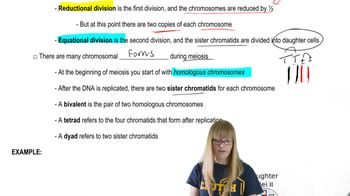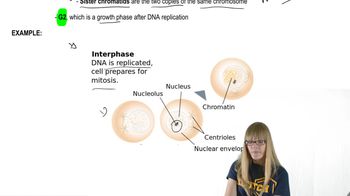Table of contents
- 1. Introduction to Genetics51m
- 2. Mendel's Laws of Inheritance3h 37m
- 3. Extensions to Mendelian Inheritance2h 41m
- 4. Genetic Mapping and Linkage2h 28m
- 5. Genetics of Bacteria and Viruses1h 21m
- 6. Chromosomal Variation1h 48m
- 7. DNA and Chromosome Structure56m
- 8. DNA Replication1h 10m
- 9. Mitosis and Meiosis1h 34m
- 10. Transcription1h 0m
- 11. Translation58m
- 12. Gene Regulation in Prokaryotes1h 19m
- 13. Gene Regulation in Eukaryotes44m
- 14. Genetic Control of Development44m
- 15. Genomes and Genomics1h 50m
- 16. Transposable Elements47m
- 17. Mutation, Repair, and Recombination1h 6m
- 18. Molecular Genetic Tools19m
- 19. Cancer Genetics29m
- 20. Quantitative Genetics1h 26m
- 21. Population Genetics50m
- 22. Evolutionary Genetics29m
7. DNA and Chromosome Structure
Eukaryotic Chromosome Structure
Problem 6
Textbook Question
During what genetic process are lampbrush chromosomes present in vertebrates?
 Verified step by step guidance
Verified step by step guidance1
Understand that lampbrush chromosomes are a special form of chromosome found in the oocytes (immature egg cells) of most vertebrates, except mammals.
Recognize that these chromosomes are characterized by their large size and extensive looping, which makes them resemble a brush used for cleaning lamps.
Identify that lampbrush chromosomes are visible during a specific stage of meiosis, the process of cell division that reduces the chromosome number by half, leading to the production of gametes (sperm and eggs).
Focus on the fact that lampbrush chromosomes are present during the diplotene stage of prophase I of meiosis, where homologous chromosomes are paired and crossing over occurs.
Note that the loops of lampbrush chromosomes are sites of active transcription, where RNA synthesis is taking place, which is crucial for the development of the oocyte.
Recommended similar problem, with video answer:
 Verified Solution
Verified SolutionThis video solution was recommended by our tutors as helpful for the problem above
Video duration:
3mPlay a video:
Was this helpful?
Key Concepts
Here are the essential concepts you must grasp in order to answer the question correctly.
Lampbrush Chromosomes
Lampbrush chromosomes are specialized structures found in the oocytes of certain vertebrates during the diplotene stage of prophase I of meiosis. They are characterized by their large size and extended loops, which are sites of active transcription. This unique morphology allows for the synthesis of RNA, facilitating the production of proteins necessary for oocyte development.
Recommended video:
Guided course

Chromosome Structure
Meiosis
Meiosis is a type of cell division that reduces the chromosome number by half, resulting in the formation of gametes (sperm and eggs). It consists of two sequential divisions: meiosis I and meiosis II. During meiosis I, homologous chromosomes are separated, while meiosis II resembles mitosis, separating sister chromatids. Lampbrush chromosomes are specifically observed during the first meiotic prophase.
Recommended video:
Guided course

Meiosis Overview
Prophase I
Prophase I is the first stage of meiosis, where homologous chromosomes pair up and exchange genetic material through a process called crossing over. This stage is crucial for genetic diversity, as it allows for the recombination of alleles. Prophase I is divided into several sub-stages, with the diplotene stage being notable for the presence of lampbrush chromosomes, indicating active gene expression.
Recommended video:
Guided course

Mitosis Steps

 7:10m
7:10mWatch next
Master Chromosome Structure with a bite sized video explanation from Kylia Goodner
Start learningRelated Videos
Related Practice


